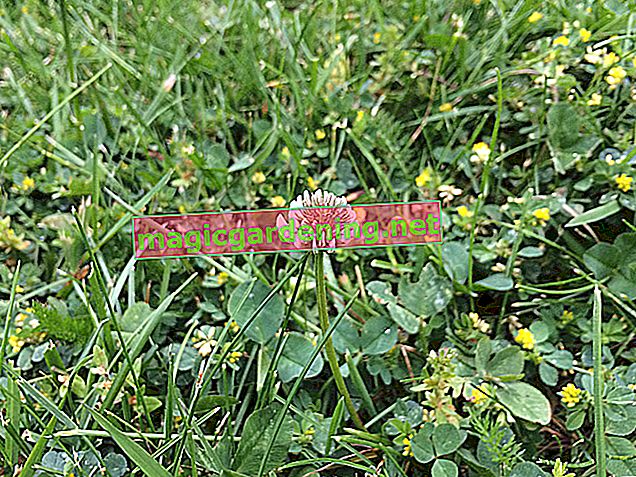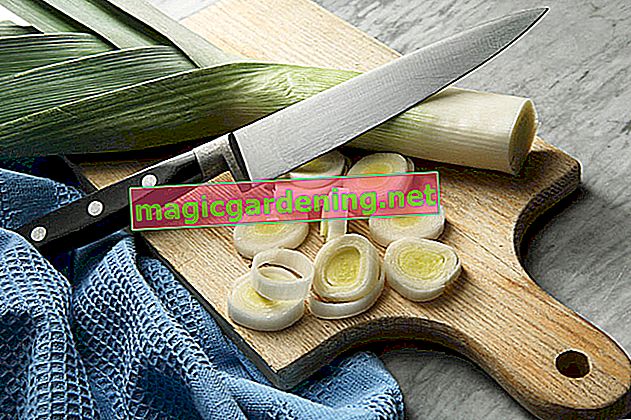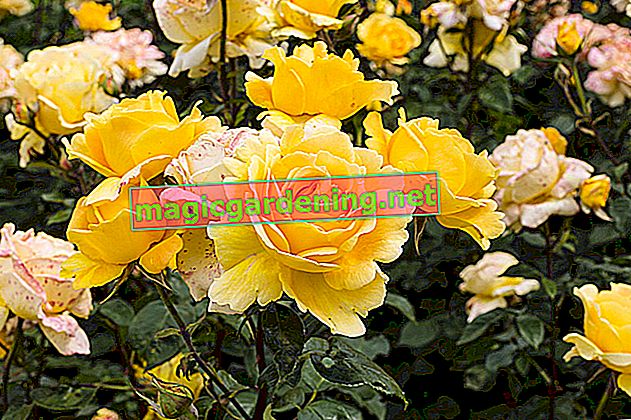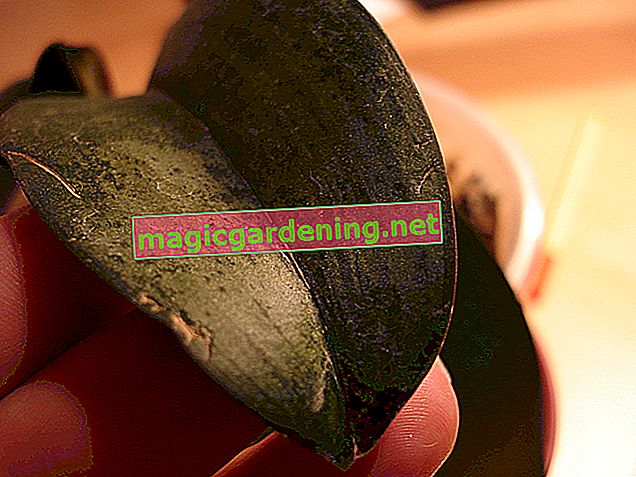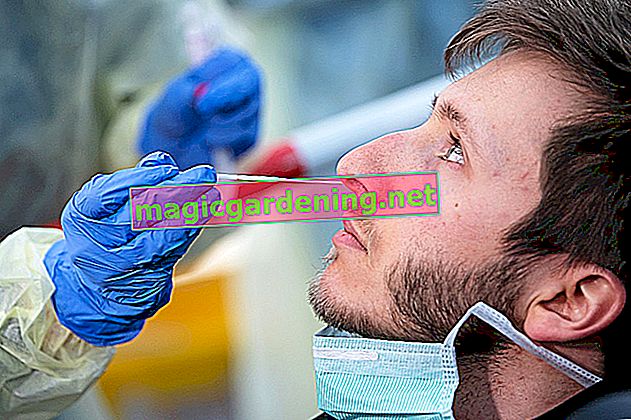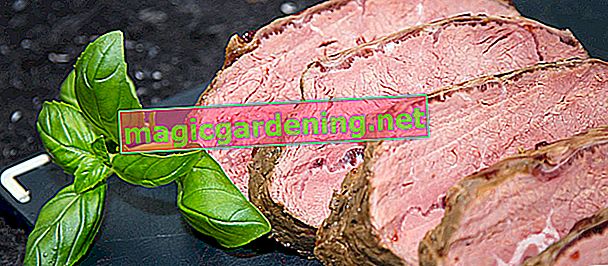
the essentials in brief
- Herbs go together when annual species stay among themselves and perennial species also form a closed society.
- Rosemary and basil go very well together as well as parsley, dill, chives, chervil and marjoram. Lemon balm goes well with almost all herbs.
- Thyme and marjoram as well as chamomile and parsley stand at war in the herb bed.
Which herbs go well together? - Rule of thumb for beginners
When herbs go well together, different criteria come into play. A herb plant often attracts beneficial insects that destroy pests on the herb neighbor. Often it is root excretions that promote mutual growth and prevent soil fatigue. Some herbalists assume that the outgassing of one variety protects the neighboring variety from disease. Advanced hobby gardeners have long been familiar with these horticultural details. Beginners orientate themselves on this empirical value:
- Rule of thumb: plant annual herbs and perennial herbs in separate beds
also read
- The art of aromas - which herbs go well together?
- Which perennials go well together - information and tips
- Mixed culture: which plants in the vegetable patch go well together?
The explanation is obvious: Perennial herbs don't like it when a new plant neighbor causes unrest every year. Annual herbs develop their optimum when they are given a new location with each next season. For this reason, the two herb categories should not be placed side by side.
Which herbs go well together? - Table for the herb bed

As the rule of thumb for the herb bed teaches us, annual and perennial herbs like to keep to themselves. Every well thought-out planting plan rests on this foundation. This criterion alone does not guarantee vital growth and a rich harvest. By taking into account the individual location requirements, the socialization of your favorite herbs becomes a successful project. The following table separates annual and perennial herb lovers, supplemented with information on the ideal lighting conditions:
| Annual herbal friends | botanical name | Location | Perennial herbal friends | botanical name | Location |
|---|---|---|---|---|---|
| basil | Ocimum basilicum | sunny | Wild garlic | Allium ursinum | partially shaded to shady |
| Summer savory | Satureja hortensis | sunny to partially shaded | Curry herb | Helichrysum italicum | sunny |
| Garden cress | Lepidium sativum | sunny to shady | tarragon | Artemisia dracunculus | sunny to partially shaded |
| chervil | Anthriscus cerefolium | sunny to partially shaded | fennel | Foeniculum vulgare | sunny |
| coriander | Coriandrum sativum | sunny to partially shaded | garlic | Allium sativum | sunny to partially shaded |
| marjoram | Origanum majorana | sunny to partially shaded | oregano | Origanum vulgare | sunny |
| parsley | Petroselinum crispum | partially shaded | sage | Salvia officinalis | sunny to partially shaded |
| rosemary | Rosmarinus officinalis | sunny | chives | Allium schoenoprasum | partially shaded |
| arugula | Eruca sativa | sunny to shady | thyme | Thymus vulgaris | sunny |
| Stevia | Stevia rebaudiana | sunny to partially shaded | Woodruff | Galium odoratum | shady |
If you still have a free spot in the herb garden in the sunny to partially shaded location, lemon balm (Melissa officinalis) should be located here. The easy-care herbal plant tolerates almost every plant neighbor and scores with a wide range of delicious uses.
Digression
Harmony in the herb pot
The crowded tightness in the herb pot calls for types and varieties that complement each other perfectly. From the category of annual herbs go well together: borage, dill, garden cress, marjoram and parsley. Do you flirt with a herb pot for several years? Then tarragon, sage, chives, thyme and lemon balm are recommended. Winter savory, oregano and sage are an unbeatable trio for a splendid herb pot on the balcony. If the location is behind glass, tropical herbs come into focus. Thai basil (Ocimum basilicum var. Thyrsiflorum), Vietnamese coriander (Polygonum odoratum) and indoor garlic (Tulbaghia violacea) thrive in peaceful coexistence on the kitchen window sill in the herb garden.Which herbs go well together? - List of dream teams

As a newcomer to hobby gardening, you don't feel like experimenting? Then please take a look at the following list with the dream teams for the herb garden. These herbs go very well together:
- Rosemary favors basil
- Chamomile promotes dill, chervil and marjoram
- Parsley strengthens dill, chives, chervil and marjoram
- Thyme goes well with savory, borage, tarragon, fennel and coriander
- Hyssop protects savory and lavender
Attentive readers should not have missed the fact that, according to this list, annual and perennial herb species are sometimes mutually beneficial. In this case, the general rule of thumb is overridden because the individual advantages gain the upper hand.
Which herbs go well together in the raised bed?
In the raised bed, herbs have a special task that goes far beyond good compatibility with one another. In close proximity to vegetables, herbal plants are useful as a natural bulwark against diseases and pests. These combinations have proven to be very effective in raised beds:
- Basil with cucumber, kohlrabi and tomatoes: works against powdery mildew and whitefly
- Savory with strawberries, beans and lettuce: repels aphids
- Garden cress with radishes and lettuce: promotes growth
- Nasturtium with potatoes, tomatoes, lettuce: attracts aphids so that vegetables remain undisturbed
- Marjoram with carrots and radishes: promotes growth
- Rosemary with cabbage, tomatoes and carrots: repels cabbage whites and carrot flies
If you plant different herbs next to each other in the raised bed, the premises previously explained in this guide apply.
Which herbs do not go together?

Decades of observations by attentive home gardeners led to the realization that some herbs in the bed should be kept at a distance. The most common cause of intolerance is growth of varying strength. Furthermore, some herbs inhibit each other's growth. While there is a lack of scientific evidence, it cannot be denied that the following herbs are incompatible:
- Never plant thyme (Thymus ssp) and marjoram (Origanum majorana) together
- Fennel (Foeniculum vulgare) not associated with coriander (Coriandrum sativum) marjoram or hyssop (Hyssopus officinalis)
- Plant basil (Ocimum basilicum) and lemon balm (Melissa) as far away as possible
- Chamomile (Matricaria) and parsley (Petroselinum crispum) do not go well together
- Always plant lovage (Levisticum officinale) and laurel (Laurus nobilis) and wormwood (Artemisia absinthium) alone, because every neighbor loses out
This category also includes herbs that are self-incompatible. In concrete terms, this means that it makes sense to change location every year to prevent the consequences of soil fatigue. These include in particular dill (Anethum graveolens), parsley, thyme and oregano.
Tips
If growth depression is rampant in the herb patch, it does not necessarily have to be due to herbal intolerance. Common causes of poor herbs and poor harvests are waterlogging, hard tap water and oily potting soil. Collect rainwater and pour herbs sparingly with soft water only when dryness is felt. Most herbal treasures want a poor, well-drained soil with no added peat as a substrate.
frequently asked Questions
Which herbs go well together for tea?
If the right herbs thrive in the garden, you can pamper yourself every day with aromatic tea from your own cultivation. On the planting plan, note lemon balm (Melissa officinalis), chamomile (Matricaria), peppermint (Mentha piperita) and sage (Salvia officinalis). These perennial herbs have similar care requirements, go well together and turn into soothing tea in hot water.
Which herbs should I plant in the flower box if I want to use them to make herb butter?
In the large flower box (€ 13.19 at Amazon *) from 100 centimeters in length, create a herb bed with these types and varieties: dill (Anethum graveolens), borage (Borago officinalis), chives (Allium schoenoprasum), cascade thyme (thymus longicaulis ssp. odoratus) and lemon balm (Melissa officinalis). Please think of drainage on the bottom of the box as protection against waterlogging. A sunny to partially shaded, warm, sheltered location is just as important as sparing watering with soft rainwater.
Which herbs and flowers go well together?
Numerous kitchen herbs find their way into the flowerbed because they inspire with beautiful flowers. In the sunny location, Purpurdost (Origanum laevigatum) boasts purple flowers that harmonize perfectly with the delicate pink flame flower (Phlox paniculata). Steppe sage (Salvia nemorosa) also likes to join in with its dark purple flowers. Curry herb (Helichrysum italicum) puts on a silver garment of leaves and vies for attention next to dark purple beard iris (Iris) and salmon pink Turkish poppy (Papaver orientale)
Are there herbs that stand better alone?
In fact, there are some herbs that prefer a lonely life. These are primarily extensive herbal plants, such as lovage (Levisticum officinale), laurel (Laurus nobilis) and rowan (Artemisia abrotanum). Furthermore, the growth of wormwood (Artemisia absinthium) is characterized by root excretions that damage other plants. Ideally, plant the above-mentioned wanderers in a large container so that their roots do not get in the way of other herbs, flowers and vegetables.
Which herbs go together in terms of taste?
The criteria of compatibility in the bed take a back seat when herbs are supposed to go together in terms of taste. Thyme and marjoram are irreconcilable neighbors. Together with rosemary, basil, tarragon, bay leaf and sage, the herbivores unite to form the legendary mixture “Herbs of Provence”. If you want to conjure up the famous “Frankfurt Green Sauce” from your own herbs, these seven species should thrive in the garden: borage, dill, parsley, garden cress, chives, pimpernelle and sorrel.
Tips
Finding the right combination of herbs for the herb spiral is one of the supreme disciplines in the hobby garden. Four climate zones of this earth come together in the smallest of spaces. The dry zone is reserved for Mediterranean herbs such as rosemary and lavender. Local herbal treasures such as wild garlic and nasturtiums can be found in the temperate and freshly humid area. Stream bungee and water celery tolerate wet feet in the water zone. You can read detailed information here.

